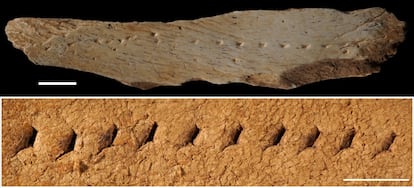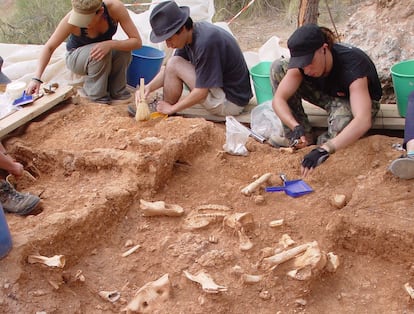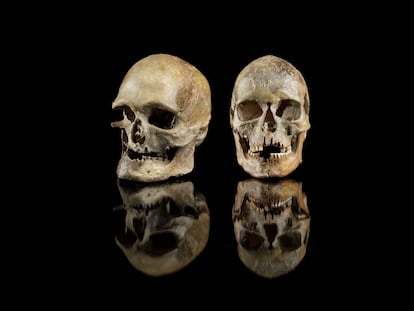Humans were already sewing their clothes nearly 40,000 years ago
A carved bone found near Barcelona was used to sew animal skin tens of thousands of years ago, well before the arrival of the needle to Europe

39,600 years ago, it was very cold in Europe. Glaciers reached the Portuguese coast and almost the entire Iberian Peninsula had a Siberian climate, where wooly mammoths roamed. The last ice age was nearing its climax when groups of modern humans — the Homo sapiens — reached this part of Europe, cornering the Neanderthals. They must have done so while dressed in tight-fitting skins. At a site near Barcelona, archeologists have identified a bone object that was used to pierce and sew leather, according to a study published this week.
“We already identified it on the ground, it had a series of marks that were not carnivore teeth or cuts or anything common,” says Montserrat Sanz, an archaeologist at the University of Barcelona. In 2007, alongside colleagues, Sanz was excavating in a gravel pit located in Canyars, an Early Upper Palaeolithic coastal site in Catalonia, Spain. Located on a river terrace, it must have been a hunting area for hyenas and felids, due to the high concentration of bones of horses, bovids and other herbivores that were found. But among so many animal bones, they found half a dozen quartz and flint stones carved in a way that could only have been done by some of the first modern humans arriving from the east. Along with the stones they also found that particular bone that so caught their attention. “Maybe there was a nearby camp, or [the Homo sapiens] passed through [the area] and left them there,” Sanz suggests. Now, microscopic analysis and a series of experiments have allowed its discoverers to determine that it was a tool for sewing skins.
The piece — about four inches wide — is incomplete, which complicates its identification. But according to its size and shape, it’s likely part of the hip or jawbone of a large herbivore — perhaps a horse or bovine. Although its collagen isn’t well-preserved enough to be able to date it, with the help of other nearby remains, scientists have managed to date it. It must have been carved about 39,600 years ago, in the middle of the Upper Paleolithic era. The date would fit with the beginnings of the Aurignacian culture, carried out by the Homo sapiens across most of Europe.
The perforations in the bone are quite special. “On one side, it has several groups of perforations, but the most striking thing is the series of symmetrical marks on the other,” says the Catalan archaeologist. These are a dozen parallel and almost equidistant indentations that intrigued them in 2007, and now they believe they have discovered what they were for. “From the Upper Paleolithic they had already found burins [a kind of awl, a small tool for piercing holes] that must have been used to work the skin, but the base was missing,” continues Sanz. And now they have found it.
Key in this discovery was Luc Doyon, an expert in bone archeology at the University of Bordeaux, France. To confirm that the marks were done by humans and weren’t the random result of animal bites, it was necessary to confirm what the modified bone was being used for. Some thought that it could be a decorative or symbolic element, but Doyon dismisses this.
“In the Aurignacian context, ornamental design that mimics natural or garment features usually appears on substantially carved objects. This is not the case with the Canyars object. We also rule out that it is a symbolic object because the modifications must be clearly visible and organized to ensure that the meaning they are meant to convey can be understood by different members of the group. Apart from the 10 aligned punctures that are easy to spot, the other 18 are arranged in a disorderly fashion,” he explains.

The study — the results of which have just been published in the journal Science Advances — supports these conclusions, after a series of experiments were conducted using carved bone replicas and stone burins.
“A careful analysis of the 28 holes [in the bone] reveal that they were made using the same technique, but with at least six different stone tools, suggesting that it was used over a fairly long period of time,” Doyon affirms. “By puncturing thick leather samples, we were able to produce punctures with similar rounded characteristics.” After comparing the results, everything indicates that the distribution of the marks on the bone surface was aimed at producing a linear stitch.
The manufacture of custom clothing must have been essential for the survival of Paleolithic people, who lived in cold climates. According to marine surveys, back then, the temperature in the Iberian Peninsula was more similar to present-day Siberia than a Mediterranean country today. Tens of thousands of years ago, at the Canyars site, the average temperature of the coldest month was never warmer than 18 degrees Fahrenheit, compared to a winter average of 41 degrees today.
Traditionally, archaeologists have linked the appearance of tight-fitting clothing — meant to keep the body warmer — to that of bone-sewing-needle technology. While needles were used in Southern Africa around 73,000 years ago and in Siberia and China around 45,000 years ago, it was once thought that needles didn’t reach Europe until around 26,000 years ago. However, the perforated bone that has been discovered suggests that skins were already being sewn in Europe about 14,000 years earlier than previously thought.
Francesco d’Enrrico, a researcher at the Center for the Behavior of the First Sapiens at the University of Bergen, Norway, argues that “the key issue for human adaptation to cold environments is being able to create tailored clothing.” To sew it, there must have been — like today — different tools and methods. Puncturing the leather skin and passing a thread through the holes would be one of them.
Regarding what was found in Canyars, d’Enrrico tells EL PAÍS via email that “the needles with an eye are important, because they probably represent a refinement of previous techniques. However, being able to pierce skin to make tailored clothing represents the real turning point in the history of human adaptation.” In addition to clothing, early humans also had to sew shoes, bags and tents.
Sign up for our weekly newsletter to get more English-language news coverage from EL PAÍS USA Edition
Tu suscripción se está usando en otro dispositivo
¿Quieres añadir otro usuario a tu suscripción?
Si continúas leyendo en este dispositivo, no se podrá leer en el otro.
FlechaTu suscripción se está usando en otro dispositivo y solo puedes acceder a EL PAÍS desde un dispositivo a la vez.
Si quieres compartir tu cuenta, cambia tu suscripción a la modalidad Premium, así podrás añadir otro usuario. Cada uno accederá con su propia cuenta de email, lo que os permitirá personalizar vuestra experiencia en EL PAÍS.
¿Tienes una suscripción de empresa? Accede aquí para contratar más cuentas.
En el caso de no saber quién está usando tu cuenta, te recomendamos cambiar tu contraseña aquí.
Si decides continuar compartiendo tu cuenta, este mensaje se mostrará en tu dispositivo y en el de la otra persona que está usando tu cuenta de forma indefinida, afectando a tu experiencia de lectura. Puedes consultar aquí los términos y condiciones de la suscripción digital.
More information
Archived In
Últimas noticias
Maduro pleads not guilty before the federal court in New York: ‘I am still the president of Venezuela’
A new test can detect Alzheimer’s from a finger prick
UN team enters Sudanese city of El Fasher after paramilitary massacre: ‘It’s like a ghost town’
A recipe for resistance: Indigenous peoples politicize their struggles from the kitchen
Most viewed
- Gilles Lipovetsky: ‘If you want to live better and fall in love, take Prozac, don’t look to philosophy’
- Alain Aspect, Nobel laureate in physics: ‘Einstein was so smart that he would have had to recognize quantum entanglement’
- Alvin Hellerstein, a 92-year-old judge appointed by Bill Clinton, to preside over Maduro’s trial in New York
- Why oil has been at the center of Venezuela-US conflicts for decades
- Maduro’s downfall puts China’s relationship with Venezuela to the test











































